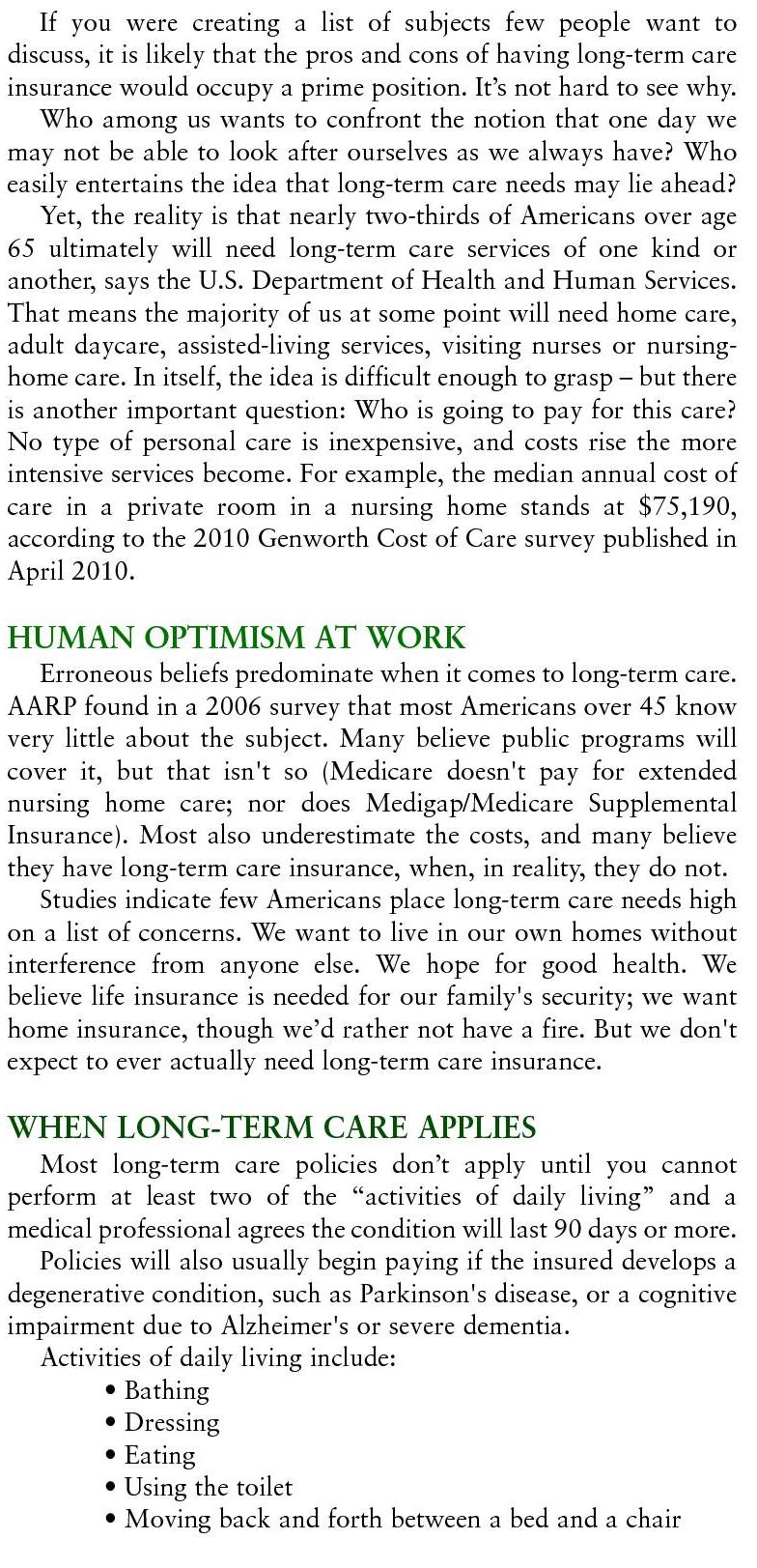10



FINANCIAL
Long-Term Care —
A Reality Check
If you were creating a list of subjects few people want to
discuss, it is likely that the pros and cons of having long-term care
insurance would occupy a prime position. It’s not hard to see why.
Who among us wants to confront the notion that one day we
may not be able to look after ourselves as we always have? Who
easily entertains the idea that long-term care needs may lie ahead?
Yet, the reality is that nearly two-thirds of Americans over age
65 ultimately will need long-term care services of one kind or
another, says the U.S. Department of Health and Human Services.
That means the majority of us at some point will need home care,
adult daycare, assisted-living services, visiting nurses or nursinghome care. In itself, the idea is difficult enough to grasp – but there
is another important question: Who is going to pay for this care?
No type of personal care is inexpensive, and costs rise the more
intensive services become. For example, the median annual cost of
care in a private room in a nursing home stands at $75,190,
according to the 2010 Genworth Cost of Care survey published in
April 2010.
WEIGH THE POSSIBILITIES
Long-term care insurance may not be necessary for everyone –
there’s a school of thought that suggests that if your portfolio is
ample enough, it might easily absorb any future long-term-care
costs without significant damage. Nevertheless, such insurance is
clearly the answer for many people, and the younger you are when
you sign up, the lower the monthly premiums will be.
In 2007, the average cost was $2,207, but premiums ranged
from $881 annually for someone under 40 to $3,026 annually for
someone 70 or older.
When considering whether you should investigate the idea of
carrying long-term care insurance, keep in mind that quality care
may be only part of the overall consideration. Such a policy can
also help to create a kind of safety net that shields family members
from having to bear unexpected financial burdens.
Long-term care policies can be complex instruments. If you’d
like to discuss whether such a policy should come from part of
your financial plan, I’d be happy to do so. Just give me a call.
â– by Kathy Greeneway
HUMAN OPTIMISM AT WORK
Erroneous beliefs predominate when it comes to long-term care.
AARP found in a 2006 survey that most Americans over 45 know
very little about the subject. Many believe public programs will
cover it, but that isn't so (Medicare doesn't pay for extended
nursing home care; nor does Medigap/Medicare Supplemental
Insurance). Most also underestimate the costs, and many believe
they have long-term care insurance, when, in reality, they do not.
Studies indicate few Americans place long-term care needs high
on a list of concerns. We want to live in our own homes without
interference from anyone else. We hope for good health. We
believe life insurance is needed for our family's security; we want
home insurance, though we’d rather not have a fire. But we don't
expect to ever actually need long-term care insurance.
WHEN LONG-TERM CARE APPLIES
Most long-term care policies don’t apply until you cannot
perform at least two of the “activities of daily living†and a
medical professional agrees the condition will last 90 days or more.
Policies will also usually begin paying if the insured develops a
degenerative condition, such as Parkinson's disease, or a cognitive
impairment due to Alzheimer's or severe dementia.
Activities of daily living include:
• Bathing
• Dressing
• Eating
• Using the toilet
• Moving back and forth between a bed and a chair
10 â– HERVOICE MARCH/APRIL 2011
Kathy Greeneway is a Certified Financial Planner® with Raymond
James Financial Services, Inc. located at First Dakota National Bank, 225
Cedar St., Yankton, SD. Securities offered through Raymond James
Financial Services, Inc., Member FINRA/SIPC, and are not insured by
FDIC, NCUA or any other government agency; are not deposits or
obligations of First Dakota National Bank; are not guaranteed by First
Dakota National Bank; and are subject to risks, including the possible loss
of principal. First Dakota National Bank and First Dakota Brokerage
Services are independent of Raymond James Financial Services.
Quality Dental
Care for Kids
The American Academy of Pediatric
Dentistry recommends your child visit
a dentist when the first tooth comes in,
usually between 6 and 12 months of
age. Early examination and preventive
care will protect your child’s smile now and
in the future. Children with healthy teeth
chew food easily and smile with confidence.
Start your child now on a lifetime of good
dental habits.
Call to set up your appointment today! 665-2448
For more information stop by our clinic at
1101 Broadway Suite 105
in the Morgen Square Plaza
or visit our website at
www.scott-family-dentistry.com



























 Previous Page
Previous Page

